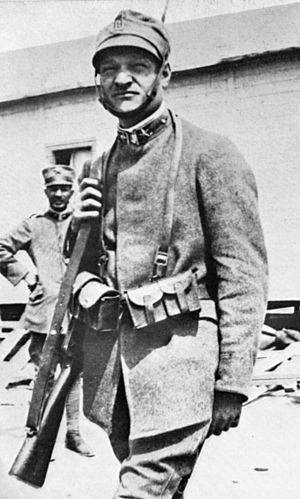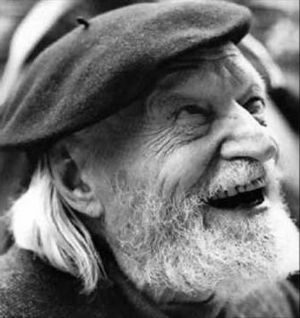Giuseppe Ungaretti facts for kids
Quick facts for kids
Giuseppe Ungaretti
|
|
|---|---|

Ungaretti in Italian infantry uniform during World War I
|
|
| Born | 8 February 1888 Alexandria, Khedivate of Egypt |
| Died | 2 June 1970 (aged 82) Milan, Italy |
| Occupation |
|
| Nationality | Italian |
| Period | 1912–1970 |
| Genre | lyric poetry, free verse |
| Subject | literary criticism |
| Literary movement | Symbolism Futurism Dada Ermetismo |
Giuseppe Ungaretti (born February 8, 1888 – died June 2, 1970) was a very important Italian poet. He was also a journalist, writer, and teacher. He won the first-ever Neustadt International Prize for Literature in 1970.
Ungaretti was a key figure in a new style of poetry called Ermetismo (meaning "Hermeticism"). This style was experimental and helped shape 20th-century Italian literature. He was influenced by Symbolism and briefly connected with Futurism.
During World War I, he fought in the trenches. This experience deeply affected his writing. He published one of his most famous works, L'allegria ("The Joy"), while serving as a soldier.
After the war, Ungaretti worked as a journalist. He also spent several years teaching in Brazil. He returned to Italy during World War II and taught at the University of Rome. He continued to write poetry for the rest of his life.
Contents
Biography
Growing up
Giuseppe Ungaretti was born in Alexandria, Egypt. His family came from Lucca, a city in Italy. His father worked on digging the Suez Canal. Sadly, his father died in an accident in 1890.
His mother then raised him. She ran a bakery on the edge of the Sahara desert. She taught him about the Roman Catholic faith.
Giuseppe started school in French at a Swiss school in Alexandria. There, he learned about different types of poetry. He studied Parnassianism and Symbolist poetry. He read famous poets like Charles Baudelaire and Arthur Rimbaud. He also learned about Italian writers like Giacomo Leopardi.
During this time, he started writing for newspapers. He wrote as a journalist and literary critic. He was interested in ideas about social change. In 1928, he returned to the Catholic faith.
Moving to Paris
In 1912, when he was 24, Giuseppe Ungaretti moved to Paris, France. On his way, he visited Rome, Florence, and Milan. In Paris, he went to lectures at the Collège de France and the University of Paris.
He met many important artists and writers there. One was the French writer Guillaume Apollinaire. Apollinaire was known for his Cubism art and was a pioneer of Surrealism. Apollinaire's work had a big impact on Ungaretti's own poetry.
Ungaretti also met Italian artists living in Paris. These included Futurism artists like Carlo Carrà and Umberto Boccioni. He also met the painter Amedeo Modigliani.
World War I and his first poems
When World War I started in 1914, Ungaretti supported Italy joining the war. He believed Italy should get back lands where Italians lived. A year later, he joined the army as an infantry soldier. He fought in the trenches in northern Italy.
The war was very difficult and shocking for him. But it also helped him discover his talent for poetry. In 1917, he published his first book of free verse poems. It was called Il porto sepolto ("The Buried Port"). Many of these poems were written while he was fighting on the front lines.
His famous book L'Allegria ("The Joy") described the hard life of a soldier. However, it also showed a sense of purpose. He wrote about the absurdity of war and the idea of brotherhood among all people.
By the end of the war in 1918, Ungaretti was back in Paris. He worked as a reporter for a newspaper called Il Popolo d'Italia. In 1919, he published a book of French poems called La guerre ("The War").
In 1920, Giuseppe Ungaretti married Jeanne Dupoix from France. They had a daughter, Ninon, and a son, Antonietto.
During his time in Paris, Ungaretti also connected with Dada. This was an art movement that challenged traditional art. He was part of a group of artists who helped connect Italian Futurism with Dada.
Hermeticism and later life
In 1921, Ungaretti returned to Italy and settled in Rome. He worked for the Foreign Ministry. He also joined the National Fascist Party. He believed that the government should support cultural development in Italy.
In 1925, Ungaretti went through a personal crisis. Three years later, he returned to the Roman Catholic Church. He continued to write poetry and contribute to many journals. In 1931, he became a foreign reporter for Gazzetta del Popolo. He traveled to Egypt, Corsica, and the Netherlands.
During this time, Ungaretti developed his unique poetic style called Ermetismo. This style was inspired by Symbolism and Futurism. In his early work, he removed traditional structure, grammar, and punctuation. Other important poets like Eugenio Montale also used this style.
Even though he was a respected poet, Ungaretti faced money problems. In 1936, he moved to São Paulo, Brazil. He became a professor of Italian at the University of São Paulo. Sadly, in 1939, his son Antonietto died there.
World War II and after
In 1942, Ungaretti returned to Italy during World War II. He was welcomed with honors. That same year, he became a Professor of Modern Literature at the University of Rome. He continued to write poems and essays.
After the war, when the Fascist government fell, Ungaretti faced challenges because of his past connections. However, his colleagues at the university voted for him to return to his teaching position.
In 1958, his wife died. Giuseppe Ungaretti found comfort in traveling. He visited Japan, the Soviet Union, Israel, and the United States.
In 1964, he gave lectures at Columbia University in New York City. In 1970, he was invited to the University of Oklahoma to receive the Books Abroad Prize. During this trip, he became ill with a lung infection. He died in Milan while receiving medical care. He was buried in Campo Verano in Rome.
Poetry
L'Allegria is a very important book in Italian literature. Ungaretti changed poetic style with new ideas. He used short, broken lines without punctuation. This was similar to Guillaume Apollinaire's poems. Ungaretti connected this style to his experiences of death and pain as a soldier.
He strongly expressed the hope for brotherhood among all people. He also wished for a new "harmony" with the universe. This is clear in the famous lines from his poem Mattina ("Morning"):
|
M’illumino |
I illuminate (myself) |
| —Santa Maria la Longa, 26 January 1917 | —Flora, August 2010 |
Another famous poem about World War I is Soldati ("Soldiers"). It describes the feelings of uncertainty and fear among soldiers:
|
Si sta come |
It's like being |
| —Bois de Courton, July 1918 | —M. Tanzy, November, 2015 |
In his later works, Ungaretti explored the power of poetic words. He believed words could save humanity from universal horror. He also looked for new ways to connect with classical Italian poetry. His last verses are in the poem l'Impietrito e il Velluto. It is about his childhood memory of an old woman named Dunja. Here is the end:
|
Il velluto dello sguardo di Dunja |
The velvet in the bright gaze of Dunja |
| —L'Impietrito e il Velluto, 1970 |
Legacy
Even though Ungaretti moved away from Ermetismo, his early experiments influenced other poets. These included Alfonso Gatto and Mario Luzi. All his collected works were published as Vita di un uomo ("The Life of a Man") around the time of his death.
Some of Ungaretti's poems have been turned into music. The American composer Harry Partch used two of his poems in his work Eleven Intrusions. The French-Romanian composer Horațiu Rădulescu set eleven of his poems to music. Composer Michael Mantler also used fragments of his poetry.
The Austrian-Hungarian composer Iván Eröd used Ungaretti's poems in four of his musical works.
Published volumes
- Il porto sepolto ("The Buried Port", 1916 and 1923)
- La guerra ("The War", 1919 and 1947)
- Allegria di naufragi ("The Joy of Shipwrecks", 1919)
- L'allegria ("The Joy", 1931)
- Sentimento del tempo ("The Feeling of Time", 1933)
- Traduzioni ("Translations", 1936)
- Poesie disperse ("Scattered Poems", 1945)
- Il dolore ("The Pain", 1947)
- La terra promessa ("The Promised Land", 1950)
- Un grido e paesaggi ("A Shout and Landscapes", 1952)
- Il taccuino del vecchio ("The Old Man's Notebook", 1960)
- Vita di un uomo ("The Life of a Man", 1969)
See also
 In Spanish: Giuseppe Ungaretti para niños
In Spanish: Giuseppe Ungaretti para niños


